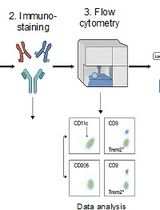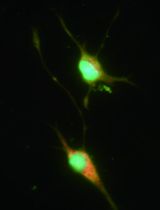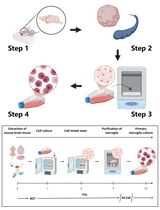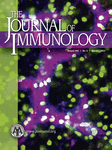- Submit a Protocol
- Receive Our Alerts
- Log in
- /
- Sign up
- My Bio Page
- Edit My Profile
- Change Password
- Log Out
- EN
- EN - English
- CN - 中文
- Protocols
- Articles and Issues
- For Authors
- About
- Become a Reviewer
- EN - English
- CN - 中文
- Home
- Protocols
- Articles and Issues
- For Authors
- About
- Become a Reviewer
Isolation and FACS Analysis on Mononuclear Cells from CNS Tissue
Published: Vol 4, Iss 18, Sep 20, 2014 DOI: 10.21769/BioProtoc.1240 Views: 13603
Reviewed by: Kanika GeraAnonymous reviewer(s)

Protocol Collections
Comprehensive collections of detailed, peer-reviewed protocols focusing on specific topics
Related protocols

Identification and Sorting of Adipose Inflammatory and Metabolically Activated Macrophages in Diet-Induced Obesity
Dan Wu [...] Weidong Wang
Oct 20, 2025 2157 Views

Selective Enrichment and Identification of Cerebrospinal Fluid-Contacting Neurons In Vitro via PKD2L1 Promoter-Driven Lentiviral System
Wei Tan [...] Qing Li
Nov 20, 2025 1292 Views

Revisiting Primary Microglia Isolation Protocol: An Improved Method for Microglia Extraction
Jianwei Li [...] Guohui Lu
Dec 5, 2025 1257 Views
Abstract
Immune cells, such as microglia are resident in the brain and spinal cord of normal mice and humans. Furthermore, macrophages, dendritic cells, T cells, B cells and NK cells infiltrate the CNS during certain infections or in neurodegenerative/neuroinflammatory diseases, such as experimental autoimmune encephalomyelitis (EAE) (a model for multiple sclerosis) or Alzheimer’s disease (Sutton et al., 2009; Browne et al., 2013). Infiltrating cells can be identified using immunohistological staining of sections from brain or spinal cords. However, more detailed phenotypic and functional analysis is possible following isolation of the immune cells from the CNS of normal or diseased mice. Purification of mononuclear cells from brain or spinal cord is dependent on perfusing the mouse to ensure removal of the blood from the CNS tissue, prior to dissociating the tissue and purification of the mononuclear cells on a percoll gradient. The technique provides single cell suspensions with cells of high viability that are suitable for FACS analysis or limited functional studies. The yields are usually low from the normal mouse brain or spinal cord, but higher from mice with EAE or CNS infection. When combined with intracellular cytokine staining and FACS, this technique is particularly useful for analysis of the pathogenic T cells (Th17 and Th1 cells) and their regulation/modulation in EAE.
Materials and Reagents
- Mice (adult >6 weeks, any strain, e.g. C57BL/6 used for MOG-induced EAE)
- Sodium pentobarbital (euthatal) (Merial)
- Phosphate buffered saline (PBS) (Sigma-Aldrich, catalog number: D8537 )
- 10x PBS (Sigma-Aldrich, catalog number: D1408 )
- RPMI solution(Sigma-Aldrich, catalog number: R0883 )
- Penicillin-streptomycin (Sigma-Aldrich, catalog number: P4333 )
- L-glutamine (Sigma-Aldrich, catalog number: G7513 )
- FBS (Sigma-Aldrich, catalog number: F9665 )
- Hank’s balanced salt solution (HBSS) (Sigma-Aldrich, catalog number: H9394 ) supplemented with 3% FBS
- Collagenase D (Roche, catalog number: 11088858001 )
- DNase I (Sigma-Aldrich, catalog number: D4263 )
- Percoll Plus (Sigma-Aldrich, catalog number: 17-5445-01 )
- Cell permeabilisation kit (contains IntraStain Reagent A and B) (Dako, Denmark, catalog number: K2311 )
- Phorbol myristate acetate (PMA) (Sigma-Aldrich, catalog number: P1585 )
- Ionomycin (Sigma-Aldrich, catalog number: I0634 )
- Brefeldin A (BFA) (Sigma-Aldrich, catalog number: B7651 )
- LIVE/DEAD® Fixable Aqua Dead Cell Stain kit (Life Technologies, catalog number: L34957 )
- CD16/CD32 FcγRIII (BD Biosciences, catalog number: 553141 )
- FACS antibodies (as appropriate)
- Propidium iodide (PI) (Sigma-Aldrich, catalog number: P4864 )
- Complete RPMI solution (see Recipes)
- FACS buffer (see Recipes)
- Stock isotonic percoll (SIP) (see Recipes).
Equipment
- 70 μm nylon mesh filter (Corning, catalog number: 352350 )
- Shaker capable of 200 rpm at 37 °C
- Tissue culture facilities including class II laminar flow hood
- Bench-top centrifuge, preferably refrigerated (any model)
- Flow cytometer
Software
- Summit software (Dako)
- FlowJo software (Tree Star)
Procedure
- Anaesthetise mice with sodium pentobarbital (40 μl i.p. ) and perfuse intracardially with sterile ice-cold PBS (20 ml). This is achieved by slowly and steadily injecting the ice-cold PBS into the left ventricle of the heart using a 20 ml syringe.
- Dissect out brains by cutting away the skull with a sharp scissors, gently removing the brain with a forceps and place in 1 ml complete RPMI solution (or HBSS supplemented with 3% FBS can be used).
- Prepare a single cell suspension by forcing the tissue through a sterile 70 μm nylon mesh filter using the plunger of a 5 ml syringe, wash with complete RPMI solution and centrifuge at 280 x g for 5 min.
- Remove the supernatant and the remaining pellet and resuspend in complete RPMI (2 ml) containing collagenase D (1 mg/ml) and DNAse I (10 μg/ml), and incubate for 1 h at 37 °C with agitation.
- Wash cells with complete RPMI and centrifuge at 280 x g for 5 min. Discard supernatants and resuspend cells in 40% Percoll [5 ml; 40% stock isotonic percoll (SIP) in PBS; 1.052 g/ml].
- Carefully layer cell suspension on top of 70% Percoll (5 ml; 70% SIP in PBS; 1.088 g/ml).
- Centrifuged at 600 x g for 20 min with the brake of the centrifuge switched off.
- Remove mononuclear cells from the 1.088:1.052 g/ml interface by aspiration with sterile plastic pipette, wash twice in complete RPMI and count.
- Samples are centrifuged at 280 x g for 5 min and cells are incubated in sterile FACS tubes at 37 °C in complete RPMI in the presence of PMA (10 ng/ml), ionomycin (1 μg/ml) and BFA (5 μg/ml) for 5 h.
- After 5 h wash the cells by centrifuging the cells at 280 x g for 5 min, ready for intracellular staining using a cell permeabilisation kit.
- Resuspend in 50 μl PBS with 1:1,000 LIVE/DEAD® Fixable Aqua Dead Cell Stain kit for 20 min at 4 °C.
- Wash cells in FACS buffer and resuspend in 50 μl FACS buffer containing CD16/CD32 FcγRIII (1: 100) and incubate at 4 °C for 10 min to block low-affinity IgG receptors.
- Incubate cells in 50 μl/sample FACS buffer containing the appropriate FACS antibodies for 15 min at 4 °C.
- Fix cells using IntraStain Reagent A (50 μl/sample) for 15 min at RT, wash twice with FACS buffer and centrifuge at 280 x g for 5 min.
- Permeabilise cells with IntraStain Reagent B (50 μl/sample) including intracellular antibodies for 15 min at room temperature in the dark.
- Wash cells twice in FACS buffer and centrifuge at 280 x g for 5 min.
- Mononuclear cells which were surface stained only are blocked for 10 min, incubated with the appropriate antibodies for 15 min at 4 °C as described above, washed twice in FACS buffer and centrifuged at 280 x g for 5 min. PI can be used as a live/dead stain (with surface staining only) by adding 1:100 immediately before reading the samples on a flow cytometer.
- Perform flow cytometric analysis on a flow cytometer and acquire data using Summit software. Analyse results using FlowJo software. Representative data can be viewed in References 1 and 2 below.
Recipes
- Complete RPMI solution
RPMI solution supplemented with 1% penicillin-streptomycin, 1% L-glutamine and 10% FBS
Note: HBSS supplemented with 3% FBS can be used as a substitute for complete RPMI solution.
- FACS buffer
PBS supplemented with 2% FBS
- Stock isotonic Percoll (SIP)
9 parts Percoll plus (from the bottle), 1 part 10x PBS
Acknowledgments
This work was funded by a PI grant to Kingston Mills from Science Foundation Ireland.
References
- Browne, T. C., McQuillan, K., McManus, R. M., O'Reilly, J. A., Mills, K. H. and Lynch, M. A. (2013). IFN-gamma production by amyloid beta-specific Th1 cells promotes microglial activation and increases plaque burden in a mouse model of Alzheimer's disease. J Immunol 190(5): 2241-2251.
- Sutton, C. E., Lalor, S. J., Sweeney, C. M., Brereton, C. F., Lavelle, E. C. and Mills, K. H. (2009). Interleukin-1 and IL-23 induce innate IL-17 production from gammadelta T cells, amplifying Th17 responses and autoimmunity. Immunity 31(2): 331-341.
Article Information
Copyright
© 2014 The Authors; exclusive licensee Bio-protocol LLC.
How to cite
Mills, K. H., McManus, R. M. and Dungan, L. (2014). Isolation and FACS Analysis on Mononuclear Cells from CNS Tissue. Bio-protocol 4(18): e1240. DOI: 10.21769/BioProtoc.1240.
Category
Immunology > Immune cell staining > Flow cytometry
Immunology > Immune cell isolation > Lymphocyte
Cell Biology > Cell isolation and culture > Cell isolation
Do you have any questions about this protocol?
Post your question to gather feedback from the community. We will also invite the authors of this article to respond.
Share
Bluesky
X
Copy link









